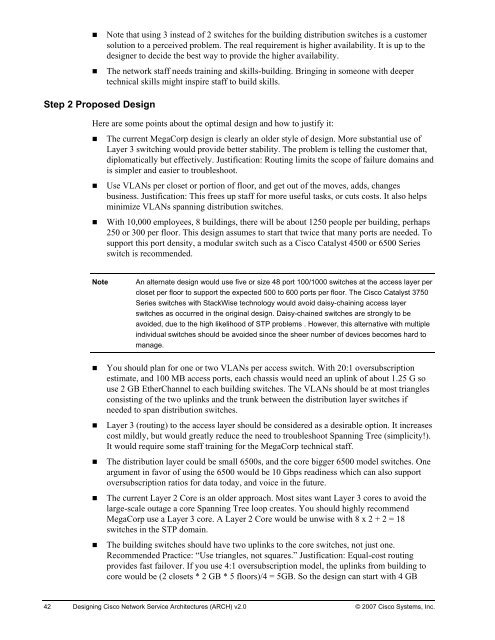Designing Cisco Network Service Architectures - Free Books
Designing Cisco Network Service Architectures - Free Books
Designing Cisco Network Service Architectures - Free Books
Create successful ePaper yourself
Turn your PDF publications into a flip-book with our unique Google optimized e-Paper software.
• Note that using 3 instead of 2 switches for the building distribution switches is a customersolution to a perceived problem. The real requirement is higher availability. It is up to thedesigner to decide the best way to provide the higher availability.• The network staff needs training and skills-building. Bringing in someone with deepertechnical skills might inspire staff to build skills.Step 2 Proposed DesignHere are some points about the optimal design and how to justify it:• The current MegaCorp design is clearly an older style of design. More substantial use ofLayer 3 switching would provide better stability. The problem is telling the customer that,diplomatically but effectively. Justification: Routing limits the scope of failure domains andis simpler and easier to troubleshoot.• Use VLANs per closet or portion of floor, and get out of the moves, adds, changesbusiness. Justification: This frees up staff for more useful tasks, or cuts costs. It also helpsminimize VLANs spanning distribution switches.• With 10,000 employees, 8 buildings, there will be about 1250 people per building, perhaps250 or 300 per floor. This design assumes to start that twice that many ports are needed. Tosupport this port density, a modular switch such as a <strong>Cisco</strong> Catalyst 4500 or 6500 Seriesswitch is recommended.NoteAn alternate design would use five or size 48 port 100/1000 switches at the access layer percloset per floor to support the expected 500 to 600 ports per floor. The <strong>Cisco</strong> Catalyst 3750Series switches with StackWise technology would avoid daisy-chaining access layerswitches as occurred in the original design. Daisy-chained switches are strongly to beavoided, due to the high likelihood of STP problems . However, this alternative with multipleindividual switches should be avoided since the sheer number of devices becomes hard tomanage.• You should plan for one or two VLANs per access switch. With 20:1 oversubscriptionestimate, and 100 MB access ports, each chassis would need an uplink of about 1.25 G souse 2 GB EtherChannel to each building switches. The VLANs should be at most trianglesconsisting of the two uplinks and the trunk between the distribution layer switches ifneeded to span distribution switches.• Layer 3 (routing) to the access layer should be considered as a desirable option. It increasescost mildly, but would greatly reduce the need to troubleshoot Spanning Tree (simplicity!).It would require some staff training for the MegaCorp technical staff.• The distribution layer could be small 6500s, and the core bigger 6500 model switches. Oneargument in favor of using the 6500 would be 10 Gbps readiness which can also supportoversubscription ratios for data today, and voice in the future.• The current Layer 2 Core is an older approach. Most sites want Layer 3 cores to avoid thelarge-scale outage a core Spanning Tree loop creates. You should highly recommendMegaCorp use a Layer 3 core. A Layer 2 Core would be unwise with 8 x 2 + 2 = 18switches in the STP domain.• The building switches should have two uplinks to the core switches, not just one.Recommended Practice: “Use triangles, not squares.” Justification: Equal-cost routingprovides fast failover. If you use 4:1 oversubscription model, the uplinks from building tocore would be (2 closets * 2 GB * 5 floors)/4 = 5GB. So the design can start with 4 GB42 <strong>Designing</strong> <strong>Cisco</strong> <strong>Network</strong> <strong>Service</strong> <strong>Architectures</strong> (ARCH) v2.0 © 2007 <strong>Cisco</strong> Systems, Inc.
















